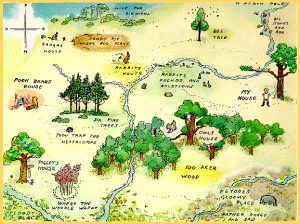 Sitemaps help make your 100 acres easier to navigate
Sitemaps help make your 100 acres easier to navigate
Welcome back. My series of SEO Tips is winding down; I hope you have gotten a lot out of them. If you have questions about this, the earlier tips or something I have yet to cover, please don’t hesitate to ask.
How could Christopher Robin ever find Pooh or Tigger’s place without his map of the 100 acre woods? Without a map, how easily could you get around in a town you’ve never been to before? Sure, you could drive up and down every street until you found your destination, but that map sure does make things a lot easier. Sitemaps do the same thing for your Web site, they help google and the others get through your site more easily.
Sitemaps are special pages, or files, created to help visitors and search spiders more easily navigate to all of the pages on your Web site. Sitemaps can be created in a couple different ways, either as traditional HTML files, or as XML files. Naturally, each has its own pros and cons.
HTML Sitemaps
Sitemaps created using traditional HTML (or other standard code) layout methods can be a life ring to stranded visitors. Done correctly they are an opportunity for you to use your preferred keywords as the anchor text (you remember how important anchor text is, right?), directing visitors and search engines in a way that most benefits you. The sitemap at apple.com is a great example of how to build one in this style. Take a peek….I’ll wait a minute. You can see that they gave careful thought about how to lay out the page and the text to use for the links. It fits the overall design of the site, making you feel welcome – not lost.
Unfortunately though, sitemaps are often treated as a necessary evil and not given the proper attention and respect. Take a look at this sitemap for a California pizza shop…not quite so nice. True, it does serve its purpose, but just barely. The biggest disadvantage to sitemaps like this is that as your site grows they can become difficult to manage over time. Keeping track of new files, files to remove or when each gets updated takes a lot of work. Additionally, if you have a large site, listing every page on your sitemap is just not practical, forcing you to decide what pages to include.
XML Sitemaps
Creating your sitemap as an XML file almost always makes it easier to create and maintain, especially if you run your site with WordPress or another content management system (CMS). There are several plugins available for WordPress that will automatically generate and update your sitemap whenever you add to or change the content on your your site – how easy is that?
The formatting of XML files is not pretty to look at (Take a look at the one on my site). Because of this, they are not intended to be browsed by your visitors, just the spiders. Since you don’t need to worry about how the files look to visitors, you are able to include every page on your site. That’s good for the spiders, very good. Some tests have shown sites that use an XML sitemap get indexed deeper, faster and more frequently than those that do not. The obvious downside to using this style of sitemap is that you have no life ring to offer your visitors if/when they get lost in your site. Thankfully though, WordPress (and other CMS) sites are generally pretty easy to navigate.
Two maps better than one?
If you have a particularly large site and are concerned your visitors might get lost, but you still want the search spiders to find all your pages, there’s no reason to not have both types of sitemaps – well, other than it’s twice the work for you. But, your visitors and traffic is worth it, right?
OK – time for you to get busy creating your own sitemap so that when the Google bot visits your site it doesn’t get trapped in Eeyores gloomy place.
Jack Leblond is a SEO/SEM professional working for a large corporation full time in Austin, TX. He is not a Realtor, he is our in-house SEO expert. Jack is the Director of Internet Strategy and Operations for TG (www.tgslc.org). In addition to managing the team that develops and maintains the company's multiple Web sites, he focuses on Search Engine Optimization (SEO), e-marketing and Social Media. Jack's background ranges from Submarine Sonar Technician/Instructor for the United States Navy, technical writer, pioneer in internet/intranet creation for McGraw-Hill and Times Mirror Higher Education, former Adjunct Professor for two Universities teaching web-related courses, has served as a city council member and co-founded Net-Smart, a web design and hosting company, where he managed networks and oversaw the development of hundreds of Web sites. As a free-lance SEO consultant, Jack performs SEO Site Audits for small/medium businesses that want their web sites to perform better in the search engine listings.











































Doug Francis
November 16, 2009 at 9:38 am
Again you had me sweating technology, especially as I went through the post and looked at the sitemap examples. I quickly went to dougfrancis.com/sitemap.xml to see what I had hoping it did not look like the pizza place. It ain’t Apple, but it looks just like yours, Jack!
Hey, that’s a “48-Hours” reference…
I do use the plug-in for my WordPress blog and really had not thought about it. A few weeks ago I started to use a “Spider Tracker” plug-in and I see they show up twice a day to index but the Googlebot seems to do 49%, Yahoo Slurp 43%, and MSN Bot 16%.
Why do they show up twice a day? And any thoughts on the % amounts?
Noel Wiggins
November 16, 2009 at 10:29 am
I have always thought the purpose to a site map was solely for search engines to link to all the pages. But even with that said my 2010 version of my site will be done in wordpress and I realized that the site map wasn’t linked from the home page, and I like the wordpress plug in that shows the stats of which bots are at the site.
—
Thanks and Regards
Noel for Nopun.com
Portland Condo Auctions
November 17, 2009 at 1:19 pm
Great tips and examples, thanks for the information. I have an XML sitemap already, but that is because I had a good SEO guy and WordPress.
Mike
December 29, 2009 at 7:59 am
Thanks for the interesting article, myself have website built on pg real estate solution, they already have this realized as well.